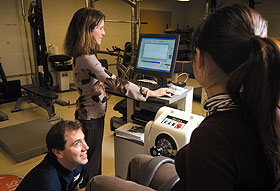  |
| HOME | THIS ISSUE | CALENDAR | PATENTS | BACK ISSUES | < BACK | NEXT > |
Kinesiologist studies cholesterol-reducing drugs and muscle pain by Beth Krane - November 10, 2008 | ||||
| Many studies have found statins to be the most effective medications for lowering cholesterol, but until now, very little research has examined a commonly reported side effect associated with the drugs: muscle pain and weakness. A large-scale clinical trial underway at three sites, including UConn’s Human Performance Laboratory, aims to pinpoint the prevalence of statin-induced muscle pain and weakness and to better understand how the most prescribed class of drugs in the world exerts its potentially harmful effects on muscles. Multi-site trial “Anecdotal evidence suggests that anywhere from 1 percent to 25 percent of patients taking statins experience some level of muscle discomfort or pain,” says Pescatello. “In some cases, muscle side effects are severe enough that patients stop taking the medications. Considering the number of people currently taking statins, the potential impact of this research could be huge.” National guidelines setting treatment goals for people with high cholesterol and cardiovascular disease recently lowered target cholesterol levels, meaning that even more people are likely to be prescribed statins in the future, Pescatello adds. Muscle symptoms associated with the drugs range from mild complaints such as pain, cramps, and weakness to muscle protein breakdown, known as rhabdomyolysis, which is extremely rare but can lead to kidney failure and death. Dr. Paul Thompson, director of cardiology at Hartford Hospital, is the grant’s principal investigator. Pescatello is the site principal investigator for UConn. Michael White, a UConn professor of pharmacy practice who has a clinical appointment at Hartford Hospital, is a site principal investigator there, responsible for double-blinding the randomized trial. The University of Massachusetts is the third site participating in the study. “According to most studies, statins produce a 30 percent reduction in cardiovascular disease,” says Thompson. “That’s phenomenal.” He notes that about 10 percent of patients taking statins report muscle pain, but it is harder to judge the number of people experiencing muscle weakness. “In this study, we’re measuring changes in exercise performance and actual damage to muscle,” Thompson says.
“Even if you don’t have muscle pain, do statins diminish muscle strength and performance?” Double-blind study Because age may affect the incidence of statin-induced muscle disease or myopathy, the researchers will split equal numbers of male and female participants into three age groups: 20-39 year olds, 40-59 year olds, and those aged 60 and older. All participants will have blood serum measured for baseline lipids or cholesterol levels, as well as for liver, kidney and thyroid function. They also will complete a baseline muscle symptom questionnaire and take part in an exercise performance test. They will then be randomly assigned to a group taking a placebo or to a group taking 80 mg of a statin daily. Neither the participants nor the researchers will know who is in which group. The research team will call participants twice a month to ascertain muscle symptoms, and will see them after three months for a safety assessment, including additional blood work. After six months or at the onset of muscle symptoms suggesting myopathy, participants will undergo exercise testing identical to that conducted at the start of the study. The research team also will collect blood and store DNA samples from participants for future research to identify and analyze genetic variants that may affect the degree to which patients taking statins experience muscle pain and weakness. Pescatello hopes that ultimately, the study’s findings may lead to the development of cholesterol-lowering drugs devoid of muscle symptoms. Pescatello’s research team is still recruiting study participants age 40 and older. Those interested in participating should contact kinesiology graduate student Matthew Kostek at 860-486-2812. |
| ADVANCE HOME UCONN HOME |

